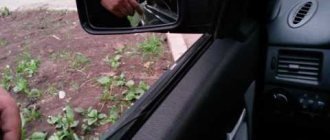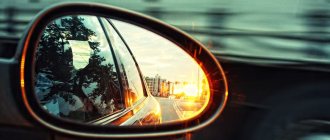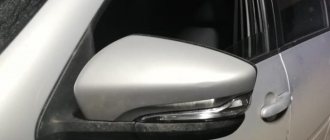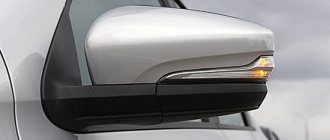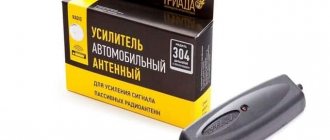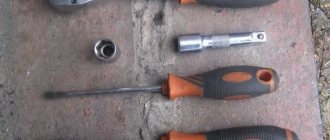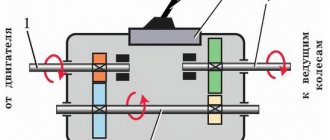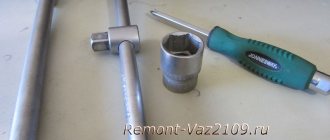Reasons for the need for replacement: all the pros and cons
If there are doubts about replacing the side mirrors on a Priora, then all positive and negative arguments should be given. Let's start with the advantages that mirrors from Priora SE really have a lot of, and they are very significant. These include:
- The process of replacing a mechanical part is technically extremely easy, and there is no need to drill, file or cut anything.
- Design - a car with new mirrors definitely looks better, which you can actually see for yourself by looking at the photo below.
- Increased level of safety - achieved through large mirrors with very good visibility without blind spots.
- A turn signal not only makes the car more attractive, but also has a positive effect on safety.
Now let's move on to familiarize ourselves with the negative sides. They really exist, and before you decide to replace the standard mirrors, you should familiarize yourself with them. These include:
- Price - new mirrors are more expensive. Their cost ranges from 3,000 thousand rubles. Of course, such a price hits the pocket hard, so not everyone can afford such a purchase. Even taking into account the fact that old mirrors can be sold (although the demand for them is very small), the price for many car owners is very high.
- The need to redo the connection diagram. This is one of the important disadvantages after the price, due to which not many people decide to replace it themselves and turn to specialists. The article describes in detail the process of connecting the new type of side mirrors on the Priora, and you can make sure that there is nothing complicated about it.
If you still decide to install new-style mirrors on the Priora, then first we’ll consider the process of dismantling the old elements.
Connecting turn signals on Priora mirrors
Good day!
I’ll say right away that this post is not for electrical gurus.
, but to help beginners) I’ll consider, I think a pressing issue today, connecting SE mirrors, what goes where and how.
So, let's begin. Firstly
, as many already know, the pads on SE mirrors are different, 6-pin, unfortunately I didn’t find these for sale in St. Petersburg, and as I understand from conversations, there are no such pads anywhere, so you’ll have to get a couple more pads for 6 or 7 contacts , I chose 7, they are paradoxically smaller. And 2 meters of wire.
Now about the transfer, in principle the wires match in the order in which they are placed in the blocks, and for some even in color. There should be no difficulties with this either. It’s better to check how you connected it right away, so as not to change everything again later. Next comes probably one of the most frequently asked questions : “What about the turn signal?! Where, how and where?”
The simplest and I think the correct way is to pull it out of the wing, pull it out, cut off the terminal, go into the interior again, unscrew the sill covers, bend the carpet and felt and reach for the engine shield. A black wire will immediately rush up to the rubber valve, this is it , take it and boldly pull it out.
One issue has been resolved. Second question
.There is wire 1 from the turn signal mirror, and 2 from the wing.
Using a tester, or empirically, we look for which of these 2 wires is “+”.
Currently, Lada Priora is equipped with electric drive and heated exterior mirrors. One of the popular modifications is the installation of side mirrors of the new SE model (with heating, electric drive and turn signal indicators). We'll tell you how to replace old-style mirrors with new ones with your own hands.
Required
: Electrically controlled external mirrors with turn indicator (article: 2170-8201050-75 and 2170-8201051-75, price about 3,500 rubles), turn signal caps SE.
Removing side mirrors on a Priora in order to replace them
The process of dismantling mirrors on Priora is not complicated and takes no more than 5 minutes. It is implemented as follows:
- The decorative trim is pryed off from the interior side and dismantled.
- The three fasteners are unscrewed with a Phillips screwdriver.
- When unscrewing the last third fastener, it is necessary to support the mirror so that it does not fall to the ground, which in 100% of cases will lead to its deformation.
- Disconnect the electrical connections. This action can be performed either after unscrewing the fastening bolts, or beforehand (after removing the decorative trim).
- Remove the mirror. The mirror on the other door is removed in a similar manner. The manufacturer's instructions are as follows.
Assembly is performed in the reverse order of removal. At this point, the dismantling process is completed, and you can immediately begin replacing products. The need to remove mirrors arises not only for the purpose of replacing them, but also for repair, modernization or restoration of appearance.
The photo below shows the serial numbers of the side mirrors that were installed on Priors.
How the process of dismantling mirrors on a Priora and their subsequent disassembly for the purpose of repairing or replacing failed parts is carried out is shown in detail in the video clip.
How to glue a rear view mirror to a car windshield
The need to dismantle the rear view mirror does not arise often, mainly in the event of an accident, collision, or impact with oncoming traffic.
Many car owners complain about the lack of methodological information on removing the rear view mirror of a Lada Vesta.
To help drivers, we will consider the main points during dismantling:
- Open the hood.
- Remove the terminals from the battery.
- Open the driver and front passenger doors wide.
- Remove the top and bottom plastic covers.
- Press the metal lock and slide the mirror up from the mount.
Note to the driver!
In the “luxury” configuration of the Lada Vesta, the rear view mirror (hereinafter referred to as the rear view mirror) is installed with a rain and light sensor. You need to move the mirror mount up. In all other configurations, sensors are not installed; the mount must be moved down.
Take this information into account when replacing the CBV to avoid damaging the equipment. Many craftsmen do not know the intricacies of attaching the interior mirror, which damages two digital sensors.
Disassembly procedure
Once the structure has been removed, disassembly can begin. If it is required, of course. Perhaps you have found a new mirror whose price suits you completely. Then you can skip this point.
If it is necessary to disassemble an element, we start from whether it is internal or external.
The interior mirror is disassembled as follows:
- there is a place where the glass and the body are connected;
- spin is inserted;
- pressed with little force;
- a gap appears;
- use a mediator to pass along the entire length of the gap;
- the body is divided into 2 parts;
- the mirror is removed;
- everything else is located underneath it;
- We carry out the necessary work.
You may also need to disassemble your car side mirror.
It doesn't matter whether left or right
- Using a hairdryer, the area between the case and the glass is heated;
- Do not heat to high temperature. Use a household hair dryer on medium power;
- Use a flat-head screwdriver to separate the body into 2 parts;
- Sometimes it is necessary to bend the terminals;
- If you are afraid of damaging the mirror, wrap the instrument with electrical tape;
- On some cars you need to slightly press the mirror to the center and move it to the side;
- The glass is carefully removed;
- Remove the screw from the plastic frame, if there is one;
- Under the frame we see the entire mechanism;
- Use a screwdriver to remove the broken structure and replace it with a new one.
That's it, the work is almost completed. But since we disassembled everything and changed the necessary components, now we need to assemble the structure and install it back on the car.
Review of Manufacturer Prices
| Name / catalog article | Price in rubles |
| LadaVesta and Lada XRAY, Renault Megane 3 with light and rain sensors (8200000509) | From 2000 - 2200 |
| Reflector without light and rain sensors (7700838529) | From 1200 |
| *price indicated as of 04/05/2019. |
Conclusion
Replacing a mirror in a Lada Vesta car yourself is quite simple. The task completes within 10 minutes. Difficulty may arise when purchasing equipment. Check the modification of the car, the presence of pre-installed rain and light sensors. There are no significant differences between domestic and foreign components. The owner of the technical equipment chooses based on personal preferences.
Reassembly
I will say right away that the assembly is carried out simply in the reverse order of the previously carried out dismantling work. Therefore, I see no point in talking about this separately.
With mirrors on special mounting brackets, everything is also extremely simple. All that remains is to tighten the fasteners and fix the mirror on the ceiling or side of the car.
But what’s really more difficult is gluing a car mirror. To begin, choose the appropriate composition. Household superglue or double-sided adhesive tape will not work. Tested by many car owners. It's better to ask for the appropriate adhesive at an auto parts store. If found, for gluing you need:
- choose a warm and sunny day without high humidity;
- create a temperature in the garage of 25-27 degrees;
- remove all dirt and traces of old glue from the body;
- walk a little along the joint with sandpaper;
- sand the gluing area on the mirror;
- degrease all surfaces;
- Apply the required thin layer of glue to the holder;
- spray the purchased activator on the fastening area;
- attach the glass to the surface;
- press the mirror to the glass;
- keep as long as the glue manufacturer said;
- remove the remnants of the used activator and glue from your mirror and also the holder itself;
- put the entire structure in its rightful place;
- use as intended.
Types of mirrors on Priora
It would not be fair to analyze the mirrors on the Priora and not mention what variants of these products the car was produced with. There are five types of mirrors for Priora:
- Autocomponent (Nizhny Novgorod plant) - mirrors that were installed on the first Prioras, transferred from the VAZ-2110. They have an electric drive, as well as a removable cover that can be removed for painting into the car body.
- The Dimitrovgrad plant is the next type of mirror that was installed on the Priora. They are distinguished by their simple design (they do not have a removable cover, so they are not intended for painting), as well as their heavy weight. Options were offered, both with electric drive and with cable drive.
- The third version of mirrors is from, which are equipped not only with electric drive, but also with heating. They have two connection blocks to the electrical circuit, and it is these options that are most often found on the restyled Priors of the “Standard” and “Norma” versions.
- The fourth option is with cable-driven adjustment. Installed on basic versions of the pre-restyling Prior. They are extremely rare.
- The fifth option is heated mirrors, electrically adjustable and a turn signal. It is these options that have become very popular. They were installed from the factory only on Prioras of the Luxury version (SE), but many car owners installed them on their cars of the budget “Standard” and “Norma” trim levels.
All of the above types of mirrors on Priora were installed from the factory. Today there are about 5 different versions of mirrors, so-called copies, which are produced by different companies, including Chinese ones. These are mainly modifications with turn signal indicators, which are in great demand and are popular among car owners.
How to disassemble a mirror (left and right) on a Priora car - removal and installation
Replacing a device that is installed on a car of the “Norma” or “Standard” trim levels with the SE version becomes a good way of tuning. In order to disassemble these devices, you will have to disassemble the interior trim. Carry out the work as follows:
- Remove the screws that secure the A-pillar trim.
- Pull part of the trim towards you.
- The part is held in place by three bolts. First, lower the glass, then slowly unscrew the bolts, taking the reflective element with your other hand.
- Do not jerk the device. First, disconnect the wires - there should be two terminals going through them. The first is for heating, the second is for position adjustment.
- Place the new part in place of the old one and secure it with bolts.
Connecting the mirrors of a Priora car should be done according to the following diagram:
- the green wire goes to the black-green one;
- red wire - to blue-red;
- connect the blue wire to the black-blue one;
- brown wire - to red-blue (second block);
- black to black wire (second block; This is the “minus” for repeaters and heating).
If you change this part in winter, when the outside air temperature drops below zero, you will have to be more careful with the mirror element. Once you remove it, you should warm it up using a hair dryer or heat gun. The surface may become chipped or “burst,” so that it remains useless. You will have to prepare for the replacement in advance by obtaining the necessary tools.
Options for mirrors on the new Priora model for replacement
On Priora you can install new mirrors from two manufacturers:
- Automotive component or ATP. They are factory marked “2170-8201051-75”. The quality of this manufacturer's products is inferior to those of the next brand.
- SALINA from - products are characterized by high quality workmanship, and these are the options that should be chosen to replace the standard options.
If you want to get really high-quality mirrors with turn signals for a Priora, then these products are the best option.
You can choose suitable mirror models on the website solina-avto.ru, where products are presented in different designs and at affordable prices. The site also presents all the necessary elements for replacement, for example, a new type of plug, fender covers instead of standard repeaters.
Connecting SE mirrors on Priora: diagram and detailed description
Let's consider connecting new-style mirrors to the Priora, where old-style products were installed, but heated and adjustable. There are options where the Priors do not have heated mirrors or have a mechanical (cable) corrector installed. However, in this case, installing mirrors of a new type is more difficult and costly, since you will need to buy additional equipment. The rationality of this method depends on how much comfort you need and how much you are willing to pay for it. That is why below is a description of the process of connecting the new model mirrors to the Priora.
Important! When carrying out work on the electrical part, be sure to first remove the negative terminal from the battery.
To begin with, it is worth noting that if a car is equipped with mirrors of a new type, but without repeaters, then there is no need to change the entire product. To do this, you can buy repeaters with overlays in the color of the car, and simply install them. Of course, you will definitely need to connect them, but this is described in detail below. The cost of Lexus type repeaters with overlays in the color of the car will cost about 2,000 rubles.
How repeaters are installed on new mirrors is shown in the video below.
After the technical installation of the new model mirror on the door, we move on to the process of connecting it, that is, the electrical part. To do this, you need to know that the block on it has 6 outputs, that is, 6-pin. Below is a diagram of its pinout by color.
On a Priora with heated mirrors and corrector, two pads are used.
To combine them with a mirror, the following options are offered:
- Cut the wires and connect directly. However, this is a barbaric method that is only suitable as a last resort.
- Buy a plug for mirrors. It costs about 200 rubles, but you can only buy it on the Internet. It is important to understand that in this case you will have to cut the standard wires in the car in order to remove the old pads. Below is a photo of the block itself and a link to the website where you can order it.
- Cut off the plug on the mirror and install the standard two pads in its place. In this case, one wire will have to be connected through “male-female”. However, this option is not advisable either, since the mirrors will be under warranty, and if they soon fail, no one will replace them. Oh, and besides, old mirrors without plugs will be harder to resell.
- Replace wiring. The most expensive, but the most correct way. You can see how to implement it in the video below.
Actually, there are many options, but they all have their drawbacks, so you should decide for yourself. However, the best way is to buy a block for a new mirror and do everything more or less carefully.
Below is a wiring diagram for the new model mirror block with standard wiring in color.
Priora SE mirror block pinout
Then only the connection is made. There are no difficulties with heated mirrors, corrector and mass. The wire for powering the dimensions should be taken from the standard turn signal, which is installed on the wing. The wire should be tightened into the interior, having first disconnected it from the ceiling lamp (read the section below for how to dismantle the turn signal lamp on the Priora wing). To do this, you need to remove the rubber plug and tighten the wire. After this, cut off the chip and insert the wire into the door niche (naturally, its length is not enough, so we increase it).
You can use this wire if you plan to dismantle the repeaters in the wing, or make an insert into it. Likewise for the other mirror. As a result, after connecting, you will get something like the following picture, as in the photo below.
It is important to note one point that if you plan to connect a turn signal and marker, then the connection technique will be different. Possible ways to implement such functionality are discussed below.
Life hack: side mirrors on Priora - removal and installation
Good visibility is important for safe driving. While driving, the driver always has to “keep his finger on the pulse” so as not to get into an unpleasant situation (accident). The side mirrors on the Priora are initially made quite well - the viewing angle is enough to sit still when reversing or changing lanes. This is not a joke, it’s really like a Kruzak review. After the Priorovskie cars I get into other cars and I miss my familiar overview. Mirrors on Priora come with turn signals (repeaters); this is the Special Edition version of Lada (luxury) Priora cars. The price of these is naturally more expensive, but not by much 900 rubles. They can be installed on a regular Priora. Turn signals in mirrors are a newfangled theme and they look beautiful and are also practical.
All that remains is to properly disassemble the mirror and make friends with the wires. Indeed, to install the modernized version you will have to put a lot of effort into finding reasons. You can do simple tuning, if you want to change the appearance to a more curly one - just put covers on the mirrors. It seems like a small change, but the car looks more solid with them.
Who hasn’t felt the thrill of using a car after ten, or a classic, freezing the car in winter - heating seems to be a common thing, but this was not the case on the VAZ. The heated mirrors of the Priora car are implemented using spirals. Often turning on heating in wet weather, a mark forms on them. Despite this, after 6 years of use, they have not faded.
Connection diagram for turn signals and side markers in Priora mirrors: method 1
First, let's look at a simple way to connect turn signal indicators (RF) in Priora mirrors. To implement it, you will need two five-pin relays, as well as 3 meters of wire and heat shrink. The implementation diagram of this method is shown in the photo below.
Connection diagram for turns and dimensions on Priora
The photo shows a diagram of connecting turn signal indicators for one mirror. For the second one it is done in the same way. If you plan to implement a connection using this scheme, then you need to know that both dimensions and repeaters will work. However, repeaters will function by breaking the dimensional chain. To put it simply, the mirror LED will be supplied with power from the dimensions. When turning on the rotation, the power supply circuit of the LED will be interrupted, which will cause it to blink. However, it will not flash synchronously with the turns, but will light up at the time when the turns go out. This is not entirely correct operation of repeaters, however, it is quite appropriate, and especially does not require major modifications. It's very easy to implement.
The principle of implementing such a scheme is very simple. First, you will need to take a five-pin relay (it is important that it is five-pin, not four), and buy a terminal block for it. Next, based on the diagram above, make the connection. A wire from the mirror is supplied to contact “87A” of the relay, which is responsible for supplying power to the turn signal. This is a white-red wire on a chip from the mirror. To power it, you will need to run a single-core wire from the passenger compartment into the door niche, where it will be connected to the chip.
Contact “30” on the relay must be connected to any wire or contact that receives power when the dimensions are turned on. This could be the LCM (light control module), wiring in the sills, or a contact on the glove compartment light. However, it is important to understand here that when you connect this wire to the power supply of the dimensions, the repeater will work when the dimensions on the car are turned on
. If you want the repeaters to work when the ignition is turned on (in this case, the dimensions on the mirrors will work), you need to connect this wire (from the “30” relay contact) to the positive of the ignition switch.
It is important to know! Since today many people drive almost constantly on the dimensions, it is better to connect the wire from contact “30” of the relay to the power supply of the dimensions.
The further connection process involves connecting pin “86” on the relay with the wire from the side turn signal. Usually the repeater light on the wing is dismantled and a chrome “SE” trim is attached in its place, the cost of which is about 100 rubles. The positive wire from the repeater must be connected to contact “86”, and the negative wire to contact “85” of the relay (it is possible and vice versa, there is no difference here). At this point, the circuit is considered assembled, and is carried out similarly for the second mirror. It is recommended to insulate all connections with heat shrink (better than electrical tape).
The most interesting thing is how it all works. Everything is very simple. When the headlights are turned on, power will be supplied to the mirror LED. When the corresponding turn is turned on (the “guitar” lever is moved up or down), power will be intermittently supplied to the relay coil. As a result, the contact on relays “30” and “87A” will be broken, which will cause the LED to blink.
The video below shows how this method is implemented and how the marker/repeater will function.
Connection diagram for turn signals and side markers on Priora: method 2
The second method is more effective, as it will ensure synchronous operation of the repeaters with the main turns. However, its implementation requires a lot of time, effort and money. Below is a diagram for its implementation.
Connection diagram for Priora left mirror repeater
Connection diagram for Priora right mirror repeater
Important! Install a jumper between relay contacts “87A” and “87A”.
The method of implementing this scheme is more complicated than the previous one, but it is more popular. After all, its main advantage is that the turn signals in the mirrors will work synchronously with the main turn signals on the car. In addition, repeaters will work regardless of whether the dimensions are turned on or not. Using the diagram it is not difficult to understand the connection features, but for clarification some information:
- Contact “30” from the relay to the mirror repeater. This is a white-red wire (but may vary from manufacturer to manufacturer).
- Contacts “87” on the relay go to the right and left turns, that is, the positive contacts from those repeaters that are located in the wings. If they are dismantled, then the wires (positive) are connected to the relay, and the negative wires are simply “muffled”.
- Contact “87A” is connected to the dimensions contact. It can be taken from the driver's side on the MUS (light module, pin “58”).
- On the passenger side in the glove compartment illumination.
- Contact “86” is connected to the steering column switch. It is needed so that power is supplied to the relay coil when the corresponding turn is turned on. It is important to understand that the wire from the passenger door must be routed to the steering column switch. The main thing is not to mix up the wires so that the right turn works on the left door, and the left turn works on the left door.
- At “85” the contact is supplied by “+” from the ignition switch.
The scheme works as follows: when the dimensions are turned on, the LEDs in the mirrors will light up, indicating the size of the car at night. This is clearly visible from the relay contacts “87a” and “30”. When the turn on the “guitar” is turned on, regardless of whether the dimensions are on or not, the repeaters will blink. This is accomplished due to the fact that there will be intermittent voltage at the coil contacts “85” and “86”. In this case, the coil will open contact “87a”, turning off the marker, and close contact “87” to turn.
Based on the diagram described above, you can assemble it yourself. At the same time, it is very important to insulate all connections with heat shrink so that everything looks civilized and moisture does not get into the contacts. Otherwise, you will soon need to disassemble the entire circuit again and clean the connections.
Wiring diagram for mirrors on Grant Liftback
There are six pins in total, of which:
- No. 1 – horizontal adjustment;
- No. 2 – —/— vertically;
- No. 3 – weight of the control unit;
- No. 4 – heating;
- No. 5 – turn signal repeater;
- No. 6 – general “minus”.
Connection diagram by wiring color
- blue – left side;
- white – side lights;
- blue – right side;
- white – black – “plus”;
- black – “minus”;
- green – common on both sides of the mirrors;
- red – general.
Wiring diagram for Lada Granta Liftback mirrors on the control unit
- gray - black and blue - black - control unit on the driver's side;
- black - “minus”;
- white-black - “plus”;
- pin No. 7 - not used. Connect third-party contacts;
- white - dimensions;
- green, orange - control unit on the passenger side.
If you want to connect Grant Liftback mirrors to a VAZ, purchase a control unit from a Lada Kalina or a VAZ Niva. The standard unit is not intended for installation on other VAZ models. The pinout of the terminals occurs according to the following diagram:
- blue – left and right side;
- black – “minus”;
- yellow – common on both sides;
- red is a plus.
Connection diagram for turn signals and side markers on a Priora: method 3
If you have the skills to use a soldering iron, then you can make some modifications to the relay, which will ensure the operation of the turn signals and markers in the exterior mirrors. Below is a diagram, the implementation of which will help ensure the operation of the backlight on the mirrors in the repeater and dimensions mode.
To implement the circuit you will need two diodes...
and two capacitors with a capacity of 4700 uF and a voltage of 35 V.
These semiconductor elements are soldered to the relay chip, as shown in the photo below.
This circuit uses a diode and a capacitor. If you compare it with the previous circuit, you can see the difference in the connection, whereby semiconductor elements are actually needed. They have a corresponding purpose, and if you decide to use this option, then consider the principle of operation of the circuit itself:
- When the dimensions are turned on, current will flow through the relay contacts “88” (aka 87A) and “30” to the LED elements of the mirror. As a result, the mirrors will work in size mode.
- When the turn signals are turned on, current will begin to flow through contacts “87” and “86” simultaneously. The positive wire of the wire is connected to these relay contacts, which powers the turn signals on the wing (it is important to connect the positive wire, not ground).
- Current is supplied to pin “86” through a diode, that is, in one direction. Next you will learn why a diode is needed. Since the second contact “85” of the relay coil is shorted to ground, it is activated. As a result, contacts “87” and “30” are closed, and the current flows directly to the LED element of the mirror. As a result, it works in turn repeater mode. Contact “88” (87A) on the relay opens while the turn signals are operating.
- It would seem that everything is simple, but why do we need a capacitor and a diode in the circuit? A capacitor is included in the circuit parallel to the coil. Its task is to prevent the coil from switching contact “88” to the operation of the dimensions while the rotation is in progress. The “86” relay contact is supplied with power from rotation. This is a positive wire through which current flows intermittently, which makes it possible for the turns to operate in the appropriate flashing mode. If you remove the capacitor from the circuit, then when turning on the turns, contacts “88” and “87” will alternately switch, which will ultimately lead to incorrect operation of the repeaters in the mirrors.
- It is precisely so that when turning on the turns, contacts “30” and “87” are closed, and do not open when the current disappears at contact “86”, a capacitor is included in the circuit. While the circuit is operating in the turning mode, it energizes the coil, which remains in the on position.
- In the circuit, a diode is needed to limit the flow of residual current generated by the capacitor back into the vehicle's electrical circuit.
Actually, this is how this scheme works, which is suitable for DIY implementation.
After this, assembly is carried out according to the above scheme, which will not be difficult. The video below shows how the repeaters and dimensions in the mirrors on a Priora function according to the diagram assembled above.
Problem and solution
Winter is coming. And here, unfortunately, side rearview mirrors cannot always help the car owner. Winter is a particularly difficult time of year for motorists. We will not now list all possible technical problems, starting with starting the engine, but will touch only on purely mechanical problems:
Let's just remember how in the morning, leaving the entrance and looking around at the cars parked nearby, it is not always possible to immediately understand which one is yours. The reason for the conspiracy is quite banal - overnight snowfall. So, your first task arises to get a shovel or other improvised means and dig out your iron horse After this, we move on to cleaning the body of the VAZ, then the windows of your car. A problem arises, what to do with the rearview mirrors? Ice and snow did not ignore them
Connection diagram for turn signals and side markers on Priora: method 4
There is another way to connect turns and dimensions in the mirrors on a Priora. This method is proposed by a person who has knowledge of electronics and assembles a circuit from semiconductor elements. The diagram is presented below. Its main advantage over those described above is the absence of relay clicks when the turn signals operate.
Connection diagram for “American” in Priora mirrors
How functional it is can only be judged by the experience of its developer. However, if you want to try it out, you can contact its developer. Here is a link to the page: https://www.drive2.ru/l/531074287772107628/, which also describes in detail the process of connecting and manufacturing the board. The video below shows how repeaters work in mirrors using special boards based on semiconductor elements.
If you connect mirrors on which Lexus repeaters are installed (when the light moves step by step), then there is no need to implement the above steps. The situation is similar for those who want only repeaters without dimensions to work on mirrors. In this case, you just need to connect the positive wire from the turn to the contact of the repeater chip on the mirror (it is best to use the one that goes to the repeater on the wing).
Finally, SE decorative elements are installed instead of turn signals in the mirrors. There is nothing complicated here, and you just need to thoroughly clean the place where the standard turn signal indicators were located on the wing, then degrease and glue.
This completes the process of replacing mirrors without turn signal indicators with new products. All that remains is to admire the result.
It definitely looks beautiful both during the day and at night. At the same time, visibility in the new elements is much better, and there are practically no “blind spots”.
Mirrors are connected in the following sequence:
- the green wire must be connected to the black-green one;
- red joins blue-red;
- The blue wire needs to be connected to the black-blue one;
- brown wire - to red-blue (second block);
- The black wires are connected together, this is the “minus” for the repeaters and heating.
Try not to work with mirrors in winter. If the thermometer drops below zero, you need to be more careful with the mirror. When you disconnect the part, heat it up using a hair dryer or heat gun. Otherwise, the surface may crack or become chipped. I'll have to throw out the mirror. Prepare in advance for replacement. Get the tools that will be useful during the work process.
Features of removing turn signal indicators on Priora
The wings of the Priora in the “Standard” and “Norma” configurations are equipped with turn signal indicators, which cause difficulties if they need to be dismantled.
The need to remove them arises if the light bulb burns out, and also if you plan to dismantle the device completely when installing repeaters in the mirrors, replacing it with the “SE” label. The process of removing the repeater on the Priora wing is very simple, and to implement it you only need a plastic card.
To remove the turn signal on the Priora's wing, you should carefully insert the card under the lampshade and press until the bracket disengages from the car body. After this, the lampshade will snap off, and all that remains is to remove it from its seat.
How this process is suggested to be performed by the manufacturer is indicated in the instructions below.
This process is shown in detail in the video below.
It remains to summarize and say that the process of replacing mirrors may seem simple at first, but in reality you will need to take a responsible approach to its implementation. And be that as it may, you should not install additional lights and other electrical appliances that will shorten the life of your generator, battery and other devices. In general, is it necessary to install new mirrors on the Priora? If this is possible with minimal cost and rework, then why not.
Basic faults
Additions to the conventional mirror element make driving even more comfortable. Just in case, the repeater makes it clear to inattentive traffic participants where the driver is going to go. Heating will promptly evaporate moisture - raindrops, and will not leave stains that distort the image. The following malfunctions may occur during operation of the machine:
The fasteners have become loose. Each part is held in place by several fasteners at different points. They may become so loose that tightening them will be useless. Everything will depend on the severity of the damage. In some cases, replacing the fasteners will be sufficient. The heating does not work. Check the connection of the wire blocks. Perhaps it is enough to strengthen the wire connections so that they no longer come loose. The electric drive does not work. Adjusting the position of mirror devices while sitting in your seat is much more convenient than doing it manually. Check the wiring. Turn signal repeater. If the repeater does not work, it means the signal is not reaching it. The problem, again, is the wiring. Broken mirror element. It will be enough to replace it with a new part, but during replacement you should be extremely careful
It is important to prevent splinters from getting under the cover.


